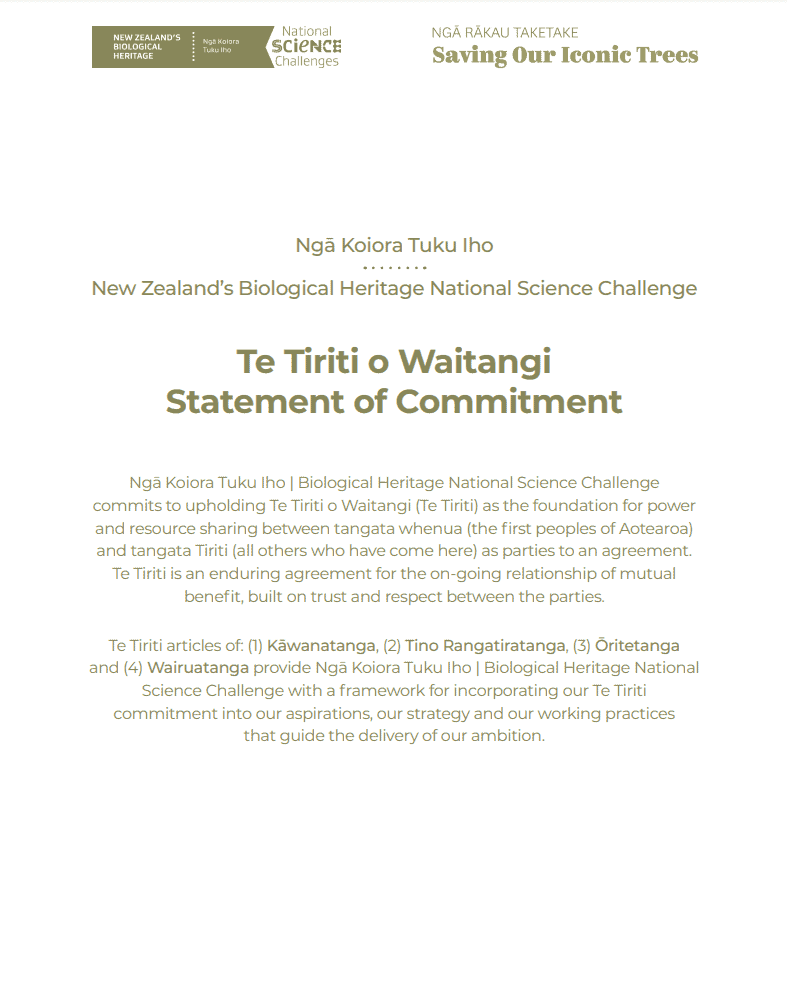Partnership with Māori

Tangata Māori (Māori people) have strong connections to Aotearoa New Zealand’s environment, valuable inter-generational views, belief systems and traditional knowledge that can underpin decision-making, governance and stewardship.
We have embraced Te Ao Māori throughout BioHeritage because these values strengthen our commitment to leaving a legacy in the Aotearoa science and innovation system.
Our strong commitment to respectful partnerships at all levels of the BioHeritage Challenge is about an exemplar approach in Aotearoa’s innovation system – to show how we can be more inclusive and diverse in science.
To ensure tangata whenua are embedded throughout the Challenge, all investments must demonstrate at least a ‘three’ on the Vision Mātauranga Classification scale – see below for details on this.
Our Principles for Partnering with Māori
- We take a proactive role in partnerships with Māori researchers and communities.
- We create opportunities for emerging Māori leaders and explore co-leadership models.
- We actively build capacity among non-Māori researchers and end-users to enable them to work confidently in partnership with tangata whenua.
- We invest in kaupapa Māori and Māori-led research.
- Co-design is a cornerstone of the way we work.
- We partner with other entities seeking to build Māori capability and capacity across the Aotearoa New Zealand science and innovation system.
- We enrich our research and innovation investments by recognising mātauranga Māori as equal to contemporary research methods.
Vision Mātauranga
Vision Mātauranga (VM) is a government science policy framework with the goal of uplifting the science and innovation potential of Māori knowledge, resources and people for the benefit of all New Zealanders. VM is woven throughout BioHeritage as an integral part of how we operate.
Our Co-Directors (Kaihautū Ngātahi and Tangata Tiriti) work in partnership to shape and drive the research. Māori members of our Leadership Group support BioHeritage investment teams to uphold VM principles and concepts, Māori world views, tikanga, mātauranga, te reo, research priorities, and kaupapa Māori methodologies.
In addition, Mana Rangatira works to ensure the Challenge operates in accordance with our best practice guidelines for partnering with Māori.
View Rauika Māngai's guide to partnering with Māori below.
Vision Mātauranga classification scale
Kaupapa Māori research:
Mātauranga Māori (about 80%+) is incorporated, used, and understood as a central focus of project and its findings. Research is grounded in Te Ao Māori (the Māori world view) and connected to Māori philosophies and principles. Research typically uses kaupapa Māori research methodologies. Te Reo Māori is often a central feature to this kaupapa or research activity, and key researchers have medium to high cultural fluency or knowledge of tikanga and reo. Generally led by a Māori researcher, however, non-indigenous researchers may carry out research under the guidance/mentoring of a Māori researcher. Māori participation (iwi/hapū/marae/individual) is high. The work contributes strongly to Māori (e.g. iwi/hapū, organisations) aspirations and outcomes and positively addresses Māori issues.
Māori-centred research:
Māori-led project, where a large amount of mātauranga Māori is used and understood (about 50%+) and combined with science (e.g. through frameworks, models, methods, tools etc.). Kaupapa Māori research is a key focus of the project. Māori are primary end-users/supporters of the work. Research is typically collaborative or consultative, with direct input from Māori groups. Commonly a collaboration with Māori researchers or researchers under the guidance/mentoring of Māori. Typically contributes to Māori (e.g. iwi/hapū, organisations) aspirations and outcomes.
Research involving Māori:
Science-based project where mātauranga Māori (about 20–50%) may be collected and incorporated in the project, but not central to the project. Research is specifically and directly relevant to Māori as end users and stakeholders. Māori are involved in the design and/or undertaking of the research (e.g. as research participants; on management/advisory/governance panels; as co-producers, partners, co-funders). The work typically contributes to Māori (e.g. iwi/hapū, organisations) aspirations and outcomes.
Research specifically relevant to Māori:
Science-based project of specific relevance to Māori as end users and stakeholders. Māori are not typically involved in the research. Mātauranga Māori and values may be used in a minor way to guide the work and its relevance to Māori. Can include work that contributes to Māori aspirations and outcomes.
Research with no specific Māori component:
Science-based project with no mātauranga Māori (Māori knowledge) used. Māori are not associated with the research process (e.g. not on any research management/advisory/governance panels, it is not inclusive of Māori land or institutions, nor the subject of any component of the research). Work may be of general interest to Māori, though no more so than to any other end users or stakeholders.
Reference for kaupapa Māori:
Smith LT 2012. Decolonising methodologies: research and indigenous peoples. 2nd ed. London and New York. Zed Books.

